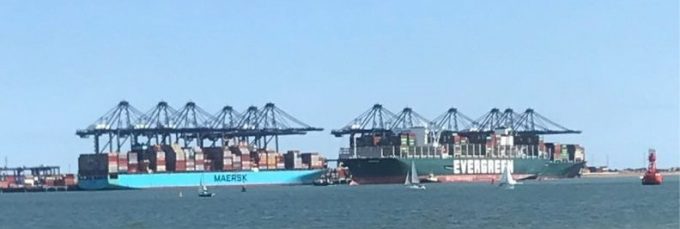Analysis: Felixstowe, London Gateway, MSC & Gemini – musical chairs in UK ports
MSC’s beady eye on Felixstowe?
BA: WIND OF CHANGEMAERSK: BULLISH CALLXPO: HEDGE FUNDS ENGINEF: CHOPPING BOARDWTC: NEW RECORDZIM: BALANCE SHEET IN CHECKZIM: SURGING TGT: INVENTORY WATCHTGT: BIG EARNINGS MISSWMT: GENERAL MERCHANDISEWMT: AUTOMATIONWMT: MARGINS AND INVENTORYWMT: ECOMM LOSSESWMT: ECOMM BOOMWMT: RESILIENCEWMT: INVENTORY WATCHDSV: GREEN LIGHT
BA: WIND OF CHANGEMAERSK: BULLISH CALLXPO: HEDGE FUNDS ENGINEF: CHOPPING BOARDWTC: NEW RECORDZIM: BALANCE SHEET IN CHECKZIM: SURGING TGT: INVENTORY WATCHTGT: BIG EARNINGS MISSWMT: GENERAL MERCHANDISEWMT: AUTOMATIONWMT: MARGINS AND INVENTORYWMT: ECOMM LOSSESWMT: ECOMM BOOMWMT: RESILIENCEWMT: INVENTORY WATCHDSV: GREEN LIGHT

Ocean carriers are resorting to more aggressive blanking strategies to manage a dip in demand, according to the latest report from project44.
The supply chain logistics and technology platform’s June Ocean Carrier Report says the 2M alliance of Maersk and MSC was “the most aggressive, cutting back its services by as much as 71% in the second week in May”.
“With ocean freight spot rates in freefall and demand for containers down year on year, carriers have moved to protect profitability,” said p44.
It suggested “other tactics”, including more slow-steaming, would be employed by shipping lines to underpin rates and mitigate the impact of soaring bunker costs.
Moreover, p44’s report notes the increasing trend of carriers to divert vessels to “more profitable” routes, leaving some network trades as “‘ghost” services –without a ship assigned.
“Vessel nominal teu capacity data shows there’s more tonnage available, but carriers appear to be putting the brakes on softening spot rates by tightening up supply on certain routes while switching tonnage to the most profitable tradelanes,” said Josh Brazil, VP of supply chain insights at p44.
Meanwhile, cargo lead times are improving, due to an easing of port congestion, and transhipment rollovers are decreasing, according to p44.
“Vessel delays across three main tradelanes – Asia-Europe, transpacific and the transatlantic – all showed signs of improvement from the horrific months of January, February and March, which were the worst months for shippers,” said p44.
It said carriers had been “able to get to grips” with rollovers last month, thus continuing the trend of monthly declines, adding: “Industry-wide, transhipment rollovers have decreased by 26.5% from a peak of 53% in January.”
Looking ahead, p44 data indicates blank sailings are set to decline in the coming weeks as carriers gear up in anticipation of the seasonal peak season.
It said its data shows Evergreen will have the lowest average percentage of blank sailings in the build-up to the peak season with, for example, the Taiwanese carrier showing just 12% of its advertised sailings will be voided next week.
“In comparison, HMM is expected to cancel up to every other sailing in July,” said p44.
In response, an HMM spokesperson said: “In July, HMM will try to keep and provide liner services as much as we can.
“As a member of THE Alliance, we have made comprehensive efforts to improve voyage productivity in cooperation with the other member lines.
“HMM and THE Alliance also suffer from voyage losses caused by severe congestion in the major ports. However, there are certainly no intentional void sailings,” he added.
P44’s ocean carrier report identifies the Ocean Alliance as “the most aggressive” of the vessel-sharing consortia in “pushing for market share”, by keeping blank sailings below the industry average.
Nevertheless, the OA may also be obliged to row back on market share grab if, as expected, inflationary fears and the tightening of monetary policy dampen global demand.
Referring to the publication of Container Trade Statistics’ 4.2% negative growth for global demand in April, p44 said the demand slump shown by the data was “hovering at similar levels to April 2019, before the dramatic collapse associated with the pandemic”.
Comment on this article